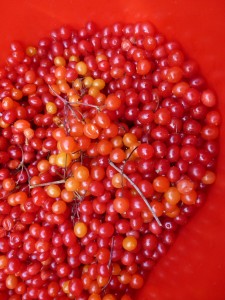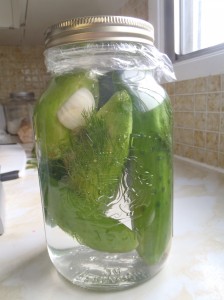 The most common form of strudel in North America is puff pastry filled with sticky jam or compote, the final product very similar to a turnover or a chausson.
The most common form of strudel in North America is puff pastry filled with sticky jam or compote, the final product very similar to a turnover or a chausson.
The original strudel, the Viennese strudel, is a different beast entirely.
Austrian strudel is made with a simple dough consisting of flour, salt, water, and vegetable oil. High protein flour is used, and the dough is mixed extensively so that there is intensive gluten development. This allows the baker to stretch the dough until it is so thin it is almost transparent. The expression in Austrian kitchens is that the dough should be thin enough that you could hold the dough over a newspaper and read the text through the dough. … Continue reading.
 Most of the highbush cranberries in the nearby park have lengthened into a distinct oval shape, which means they’re ready for picking.
Most of the highbush cranberries in the nearby park have lengthened into a distinct oval shape, which means they’re ready for picking.
Often when harvesting or foraging in balmy summer, I find myself looking forward to the colder months ahead.
Much of the past year has been devoted to exploring seasonality beyond ingredients: looking at traditional dishes and meals that mark the season. I pick highbush cranberries mostly for use in two meals: Thanksgiving and Christmas dinners. (If there’s a little extra that can be enjoyed in November with some game meats, all the better.) So as I romp through the bush in late summer, I’m actually thinking about fall and winter.
Similarly, when candying cherries in August, I might … Continue reading.
Yet ev’n this Season Pleasance blithe affords,
Now the squeez’d Press foams with our Apple Hoards.
-John Gay
To most contemporary city-folk the word “cider” implies fermented apple juice. My grandparents made the distinction between “cider” (juice pressed from apples) and “hard cider” (fermented apple juice). For now I have simply made cider, and will leave the discussion of hard cider and its variants for another post.
This week we picked about 150 lbs of apples from three different trees:
- one beautiful, well-trained tree yielding large, blushing apples, which I will be referring to as “Ron’s apples”;
- one crabapple tree with bright red, tart fruit;
- one hideous, unkempt tree in our backyard that grows small green apples. The tree
…
Continue reading.
Step One: Acquire Grouse
A friend’s father, Mr. McLarney, hunts game birds with his English pointer. I had never, not once, paused to consider the signficance of common canine descriptors like pointer, setter, and retriever, until Mr. McLarney’s hunts were explained to me. The dog walks a ways in front of him, and when it comes upon a bird it stops and “points”: it aims its snout at the prey. Mr. McLarney moves within range and readies his gun, then makes a call to the pointer. At the signal, the dog scares the bird into flight, so that Mr. McLarney can pull it from the sky with his shotgun.[1]
Mr. McLarney trained his pointer in his backyard with a … Continue reading.
A few of the many wild edibles that are in season in and around Edmonton in early fall:
Highbush Cranberries
Highbush cranberries are traditionally picked after the first frost, when they are said to be sweetest. I don’t know if the freezing temperature itself does something to sweeten the fruit, or if it’s simply that waiting until the first frost gives the fruit the longest possible time to ripen and sweeten.
Cool, cloudy summers like the one we’ve just had yield berries with more acid and less sugar. Even so, the berries will still be good, so go pick a handful to save for Thanksgiving dinner.

Chokecherries
Cornucopic clusters of chokecherries hang along the trails of the river valley this … Continue reading.
 I come from a land of “refrigerator pickles”: cucumbers steeped in syrupy vinegar and spices, and stored in the fridge through the fall. There is another type of pickle called a lacto-fermented pickle. The idea of producing an acidic pickle with only brine was a revelation.
I come from a land of “refrigerator pickles”: cucumbers steeped in syrupy vinegar and spices, and stored in the fridge through the fall. There is another type of pickle called a lacto-fermented pickle. The idea of producing an acidic pickle with only brine was a revelation.
There are two ways to apply the salt and control the salt concentration: either dry salt can be added directly to the ingredient, or the ingredient can be submerged in a brine.
Direct Salting. This method is more common when the ingredient to be fermented has been sliced or chopped finely. Sauerkraut is the most familiar example in the west. For this method we typically add about 2% of the weight of the ingredient … Continue reading.
The personal website of Edmonton chef Allan Suddaby
 The most common form of strudel in North America is puff pastry filled with sticky jam or compote, the final product very similar to a turnover or a chausson.
The most common form of strudel in North America is puff pastry filled with sticky jam or compote, the final product very similar to a turnover or a chausson.
